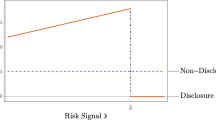Abstract
This study provides new evidence that IPO underpricing is economic rents paid for investor to gather costly information. Subrahmanyam and Titman (1999) report that diverse investor information, once aggregated in the public market, could provide a more informative stock price and accurate feedback to firm’s investment decision. I investigate the hypothesis that IPO underpricing as economic rents could be higher, when investor information is diverse. In support of this hypothesis, I find a positive and significant correlation between the extent of underpricing and the information diversity measure proposed by Barron et al. (1998). There is a positive and significant correlation between this information diversity measure and an IPO firm’s subsequent (absolute) change in capital and R&D expenditures. In addition, firms with high information diversity measure and change in subsequent investment exhibit a better subsequent return performance than firms with low diversity and change in investment. This is consistent with the proposition that investor information serves as useful feedback for managers in the IPO market.
Similar content being viewed by others
References
Aggarwal, R., L. Krigman and K. Womack, “Strategic IPO Underpricing, Information Momentum, and Lockup Expiration Selling.” Journal of Financial Economics 66, 105–137 (2002).
Allen, F. and G. Faulhaber, “Signaling by Underpricing in the IPO Market.” Journal of Financial Economics 23, 303–324 (1989).
Baron, D., “A Model of the Demand for Investment Banking Advising and Distribution Services for New Issues.” Journal of Finance 37, 955–976 (1982).
Barron, O. E., D. Byrad, C. Kile and E. Ried, “High-Technology Intangibles and Analysts’ Forecasts.” Journal of Accounting Research 40, 289–312, (2002).
Barron, O. E., Kim Oliver, C. Lim Steve and E. Stevens, Douglas “Using Analysts’ Forecasts to Measure Properties of Analysts’ Information Environment.” Accounting Review v73, 421–433 (1998).
Barron, O. E., D. Byrad and O. Kim, “Changes in Analysts’ Information Around Earnings Announcements.” The Accounting Review 77(4), 821–846 (2002).
Beatty, R. and J. Ritter, “Investment Banking, Reputation, and the Underpricing of Initial Public Offering.” Journal of Financial Economics 15, 213–232 (1986).
Beatty, R. P. and I. Welch, “Issuer Expenses and Legal Liability in Initial Public Offerings.” Journal of Law and Economics 39, 545–602 (1996).
Benveniste, L. M., Walid Y. Busaba and W. J. Wilhelm, Jr, “Information Externality and the Role of Underwriters in Primary Equity Markets.” Journal of Financial Intermediation 11, 61–86 (2002).
Benveniste, L. M. and P. A. Spindt. “How Investment Bankers Determine the Offer Price and Allocation of New Issues.” Journal of Financial Economics 24, 343–362 (1989).
Booth, J. R. and L. Chua, “Ownership Dispersion, Costly Information, and IPO Underpricing.” Journal of Financial Economics 41, 291–310 (1996).
Busaba, W., L. M. Benveniste and R. Guo, “The Option to Withdraw IPOs During the Premarket: Empirical Analysis.” Journal of Financial Economics 60, 73–102 (2001).
Byrad, D. and K. W. Shaw, “Corporate Disclosure Quality and Properties of Analysts’ Information Environment.” Journal of Accounting, Auditing, and Finance 18, (2003).
Carter, R., F. Dark and A. Singh, “Underwriter Reputation, Initial Returns, and the Long-Run Performance of IPO Stocks.” Journal of Finance 53, 285–311 (1998).
Carter, R. and S. Manaster, “Initial Public Offerings and Underwriter Reputation.” Journal of Finance 45, 1045–1068 (1990).
Chemmanur, T. J. “The Pricing of Initial Public Offerings: a Dynamic Model with Information Production.” Journal of Finance (1993).
Fama, E. F and K. R. French, “Common Risk Factors in the Returns on Stocks and Bonds.” Journal of Financial Economics 33(1), 3–56 (1993).
Grinblatt, M. and C. Hwang, “Signaling and the Pricing of New Issues.” Journal of Finance 44, 393–420 (1989).
Hanley, K., “The Underpricing of Initial Public Offerings and the Partial Adjustment Phenomenon.” Journal of Financial Economics 34, 231–250 (1993).
Ibbotson, R., J. Sindelar and J. Ritter,“Initial Public Offerings.” Journal of Applied Corporate Finance 1, 37–45 (1988).
Jegadeesh, N., M. Weinstein and I. Welch. “An Empirical Investigation of IPO Returns and Subsequent Equity Offerings.” Journal of Financial Economics 34, 153–175 (1993).
Jenkinson, T. and A. Ljungqvist, Going public: The Theory and Evidence on How Companies Raise Equity Finance, 2nd edition. Oxford University Press, Oxford, UK.
Jos van Bommel, J. and T. Vermaelen, “Post-IPO Capital Expenditures and Market Feedback.” Journal of Banking and Finance 27, 275–305 (2003).
Loughran, T. and J. Ritter, “The New Issues Puzzle.” Journal of Finance 51, 23–52 (2003).
Loughran, T. and J. Ritter, “Why has IPO Underpricing Changed Over Time?” Financial Management 33(3), (5–37) 2004.
Megginson, W. and K. Weiss, Venture capitalist Certification in Initial Public Offerings.” Journal of Finance 46, 879–903 (1991).
Maksimovic, V. and P. Pichler, “Technological Innovation and Initial Public Offerings.” Review of Financial Studies 14, 459–494 (2001).
Moskowitz, T. and M. Grinblatt, “Do Industries Explain Momentum?” Journal of Finance 54, 1249–1290 (1999).
Ritter, J., “The Long-Run Performance of Initial Public Offerings.” Journal of Finance 46, 3–27 (1991)
Ritter, J. R., “Investment Banking and Securities Issuance.” In G. Constantinides, M. Harris and R. Stulz (Eds.) Handbook of the Economics of Finance North-Holland, New York, NY.
Ritter J. R. and I. Welch. “A Review of IPO Activity, Pricing, and Allocations.” Journal of Finance 57, 1795–1828 (2002).
Rock, K., “Why New Issues are Underpriced.” Journal of Financial Economics 14, 187–212 (1986).
Schultz, P., “Pseudo market timing and the Long-Run Performance of IPOs.” Journal of Finance 58, 483–517 (2003)
Sherman, A. E. and S. Titman, “Building the IPO Order Book: Underpricing and Participation Limits with Costly Information.” Journal of Financial Economics 65, 3–29 (2002).
Spatt, C. S. and S. Srivastava, “Preplay Communication, Participation Restrictions, and Efficiency in Initial Public Offerings.” Review of Financial Studies 4, 709–726 (1991).
Subrahmanyam, A. and S. Titman, “The Going-Public Decision and the Development of Financial Markets.” Journal of Finance 54, 1045–82 (1999).
Subrahmanyam, A. and S. Titman, “Feedback from Stock Prices to Cash Flows.” Journal of Finance 56, 2389–2413 (2001).
Author information
Authors and Affiliations
Corresponding author
Additional information
JEL Classification: G32
Rights and permissions
About this article
Cite this article
Guo, RJ. Information Collection and IPO Underpricing. Rev Quant Finan Acc 25, 5–19 (2005). https://doi.org/10.1007/s11156-005-3176-9
Issue Date:
DOI: https://doi.org/10.1007/s11156-005-3176-9




